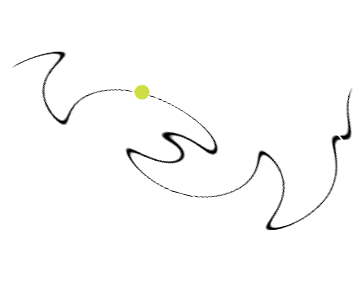Atomic Models and the Quantum Numbers
There are different models of the structure of the atom. One of the first models was created by Niels Bohr, a Danish physicist. He proposed a model in which electrons circle the nucleus in "orbits" around the nucleus, much in the same way as planets orbit the sun. Each orbit represents an energy level which can be determined using equations generated by Planck and others discussed in more detail below. The Bohr model was later proven to be incorrect, but provides a useful model for building an explanation.The "accepted" model is the quantum model. In the quantum model, we state that the electron cannot be found precisely, but we can predict the probability, or likelihood, of an electron being at some location in the atom. You should be familiar with quantum numbers, a series of three numbers used to describe the location of some object (like an electron) in three-dimensional space:
- n: the principal quantum number, an integer value (1, 2, 3...) that is used to describe the quantum level, or shell, in which an electron resides. The principal quantum number is the primary number used to determine the amount of energy in an atom. Using one of the first important equations in atomic structure (developed by Niels Bohr), we can calculate the amount of energy in an atom with an electron at some value of n:
En = - Rhc
n2
R = Rydberg constant, a value of 1.097 X 107 m-1
c = speed of light, 3.00 X 108 m/s
h = Planck's constant, 6.63 X 10 -34 J-s
n = principal quantum number, no unitFor example, how much energy does one electron with a principal quantum number of n= 2 have?
En = - Rhc
n2or En = - (1.097x107 m-1 ∗ (6.63x10-34 J•s)∗(3.0x108 m•s-1)
22= 5.5x10-19 J You might ask, well, who cares? In addition to the importance of knowing how much energy is in an atom (a very important characteristic!), we can also derive, or calculate, other information from this energy value. For example, can we see this energy? The table below suggests that we can. For example, suppose that an electron starts at the n=3 level (we'll call this the excited state) and it falls down to n=1 (the ground state). We can calculate the change in energy using the equation:
ΔE = hv = RH 1
ni2- 1
nf2Where:
ΔE = change in energy (Joules)
h = Planck's constant with a value of 6.63 x 10-34 (J-s)
ν is frequency (s-1)
RH is the Rydberg constant with a value of 2.18 x 10-18J.
ni is the initial quantum number
nf is the final quantum numberUsing the equation below, we can calculate the wavelength and the frequency of the energy. The wavelength and the frequency give us information about how we might "see" the energy:
vλ = c
ν = the frequency of radiation (s-1)
λ = the wavelength (m)
c = the speed of light with a value of 3.00 x 108 m/s in a vacuumSpeed of light = 3.00E+08 Rydberg constant = 2.18E-18 Planck's constant = 6.63E-34 Excited state, n = 3 4 5 Ground state, n = 2 2 2 Excited state energy (J) 2.42222E-19 1.363E-19 8.72E-20 Ground state energy (J) 5.45E-19 5.45E-19 5.45E-19 ΔE = -3.02778E-19 -4.09E-19 -4.58E-19 ν = 4.56678E+14 6.165E+14 6.905E+14 λ(nm) = 656.92 486.61 434.47 - l ("el", not the number 1): the azimuthal quantum number, a number that specifies a sublevel, or subshell, in an orbital. The value of the azimuthal quantum number is always one less than the principal quantum number n. For example, if n=1, then "el"=0. If n=3, then l can have three values: 0,1, and 2. The values of l are typically not identified as "0, 1, 2, and 3" but are more commonly called by their historic names, "s, p, d, and f", respectively. Since the quantum numbers were discovered through the study of light and lines on an electromagnetic spectra, chemists identified the lines by their quality:sharp, principal, diffuse and fundamental. The table below shows the relationship:
Value of l Subshell designation 0 s 1 p 2 d 3 f - m: the magnetic quantum number. Each subshell is composed of one or more orbitals. In the study of light, it was discovered that additional lines appeared in the spectra produced when light was emitted in a magnetic field. The magnetic quantum number has values between -l and +l. When l =1, for example, m can have three values: -1, 0, and +1. Because you know from the chart above that the subshell designation for l =1 is "p", you now know that the p orbital has three components. In your study of chemistry, you will be presented with px, py, and pz. Notice how the subscripts are related to a three-dimensional coordinate system, x, y, and z. The chart below shows a summary of the quantum numbers:
Principal Quantum Number (n) Azimuthal Quantum Number (l) Subshell Designation Magnetic Quantum Number (m) Number of orbitals in subshell 1 0 1s 0 1 2 0
12s
2p0
-1 0 +11
33 0
1
23s
3p
3d0
-1 0 +1
-2 -1 0 +1 +21
3
54 0
1
2
34s
4p
4d
4f0
-1 0 +1
-2 -1 0 +1 +2
-3 -2 -1 0 +1 +2 +31
3
5
7
Chemists care about where electrons are in an atom or a molecule. In the early models, we believed that electrons move like billiard balls, and followed the rules of classical physics. The graphic below attempts to show that earlier models thought that we could identify the exact path, position, velocity, etc. of an electron or electrons in an atom:

A more accurate picture is that the electron(s) reside in a "cloud" that surrounds the nucleus of the atom. This concept is shown in the graphic below:


No comments:
Post a Comment